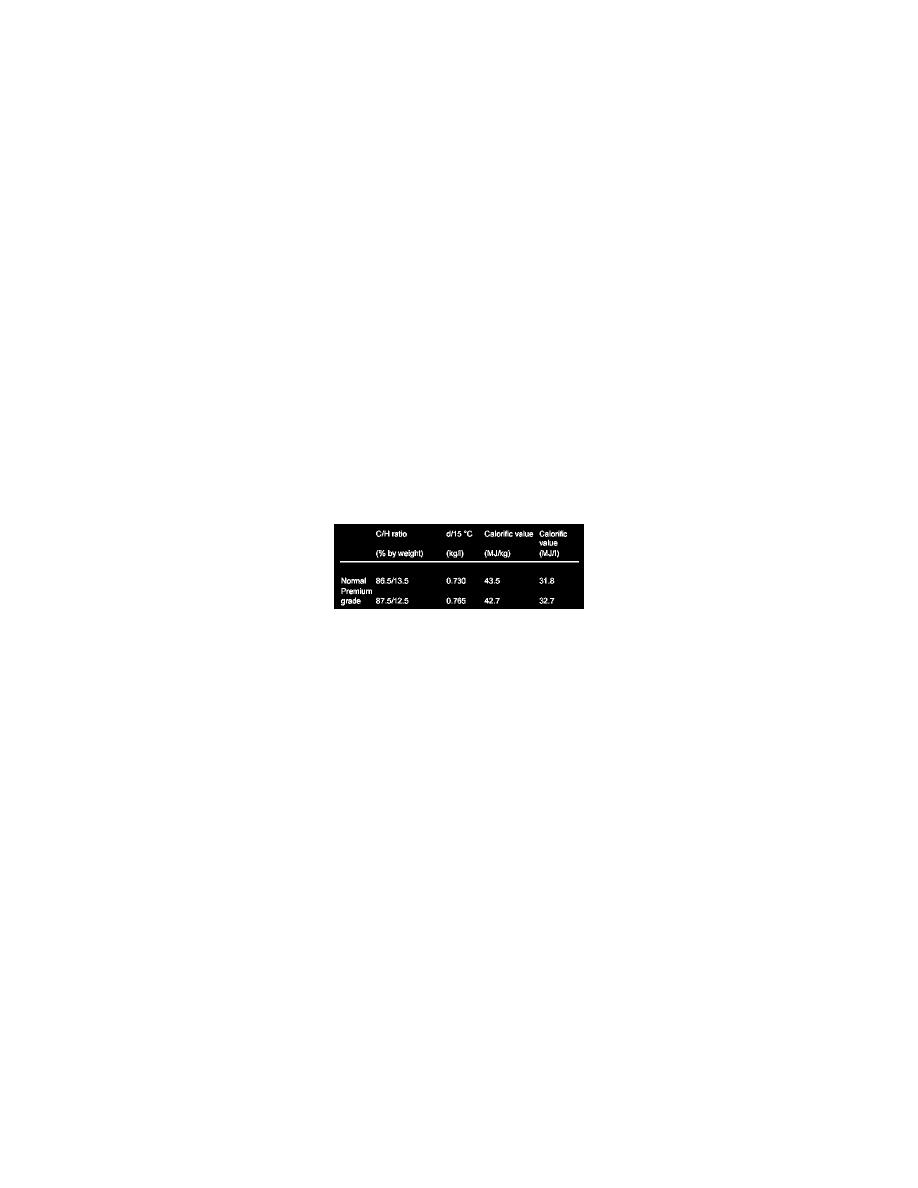ForTwo L3-1.0L (2009)

lower values than the "DVPE", nonalcohol fuels are evaluated identically.
DIN EN 228 specifies the "DVPE" vapor pressure in summer to min. 45 and max. 60 kPa as well as for the winter to min. 60 and max. 90 kPa (100 kPa
= 1 bar). In the transitional period during spring and fall the vapor pressure requirements for winter fuel are valid, but with an additional requirement in
terms of the "VLI" ("Vapor Lock Index", a mathematical value: VLI = 10 * DVPE + 7 * E70) of max. 1150, when the vapor pressure is fully exploited
(e.g. 90 kPa) this limits the permissible vaporized pressure at 70°C ("E 70") to max. 28.5 % by volume.
The European standard provides an opportunity, to also define the vapor pressure curve above 37.8°C (from 40°C up to 100°C) (EN 13016 T. 2). There
are as yet hereto no limit values.
Density
Density is related to 15°C as under DIN 51757 and ISO 3675 because of the volume which changes with the temperature.
Density requirements as under DIN EN 228 for regular, premium. and super plus are 0.720 up to 0.775 kg/m 3
Calorific value
The calorific value of the fuel indicates which quantity of heat is liberated when it is combusted, i.e. how much energy is contained in a particular
quantity of fuel. The measuring unit for the calorific value is MJ/kg. One differentiates between the specific gross calorific value (upper calorific value)
and the specific calorific value (net calorific value), they represent the quantity of heat in relation to the mixture, which is released during combustion,
once with and once without taking account of the condensation heat of the formed water. Because the exhaust gases constantly exhibit a temperature
higher than 100°C, it is only the net calorific value that is of any interest in engine-related combustion.
In fuels that consist solely of carbon (C) and hydrogen (H), the calorific value is dependent on their C and H concentrations, this is because H has a
calorific value of 119.8 MJ/kg, whereas C only has a calorific value of 33.9 MJ/kg. The C/H ratio (in % by weight C/H) of fuels is however only variable
in close limits, namely theoretically from 86/14 to 88/12, the associated calorific values are around 43.8 and 42.5 MJ/kg, i.e. the maximum difference is
around 3 %. As on the other hand fuels with a high C/H ratio inevitably have a higher density and fuels are sold by volume and not by weight, the
calorific values stated should be multiplied by the associated densities in order to arrive at real ratios. For example, regular and premium-grade fuels with
the following data:
In other words the energy contained in 1 l premium fuel is roughly 2.8 % greater than that for 1 l of regular-grade gasoline.
If the fuel contains oxygenic components, the oxygen will not contribute anything to its calorific value. The oxygen content should therefore be
subtracted. This is to a certain extent compensated for by the higher H content in the oxygenic compounds, so that where the proportion is not too high
(see section on "Oxygenic components") the calorific value is only insignificantly influenced.
Purity
Solid foreign matter and water may lead to problems arising with the fuel supply. Beyond this water can also cause corrosion; in turn corrosion products
can also impair the fuel supply. The solid residue from evaporation of the fuel (50 ml of the fuel is evaporated by the air-jet method in a glass beaker at a
temperature of 160°C) gives an indication of the degree of contamination to be expected in the intake system. Oily solid residue from evaporation is less
harmful, but paint or resin residue from evaporation is less favorable.
The sulfur content in the gasoline should be as low as possible, we recommend the use of sulfur-free fuel in Mercedes-Benz vehicles. For additional
information see Sheet 126.0 "Sulfur in gasoline".
Stability
The quality of the fuels should not deteriorate on the more or less long journey from the manufacturer to the consumer, i.e. the hydrocarbons in the fuel
should not react with the oxygen in the air or with each other. This chemical instability results from the presence of unsaturated hydrocarbons in the fuel
(e.g. diolefines) and is responsible for the so-called "gum" formation. This makes itself noticed through deposits throughout the entire fuel and intake
systems and the intake valves.
The oxidation stability as per ISO 7536 and the residue from evaporation are used as assessment criteria.
Currently however, a proper quality assessment can only be made through a complete engine test.
Corrosion
Fuels are naturally practically anhydric, but they are known to dissolve small quantities of water when being transported. The dilution is dependent on
the structure of the hydrocarbons as well as the temperature. When cooling down a portion of the diluted water is lost. Water and fuel are separated. As
